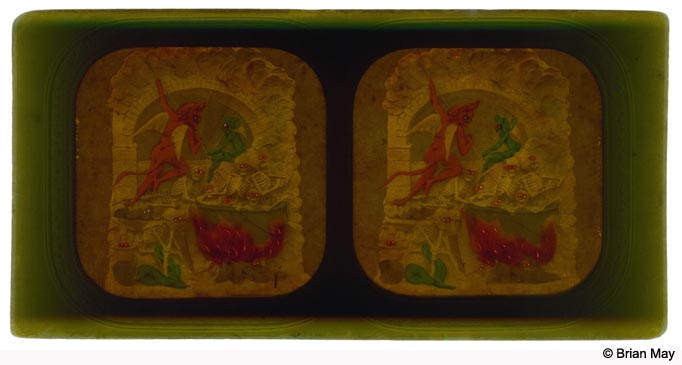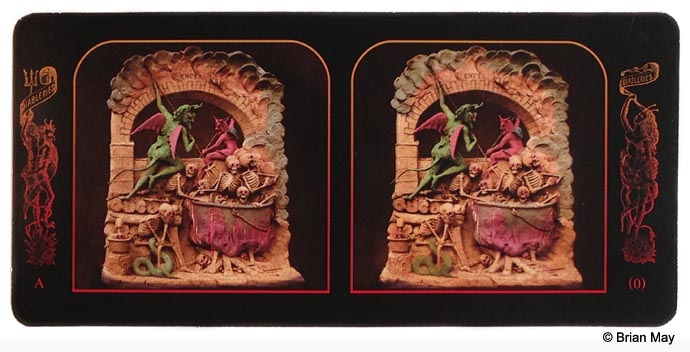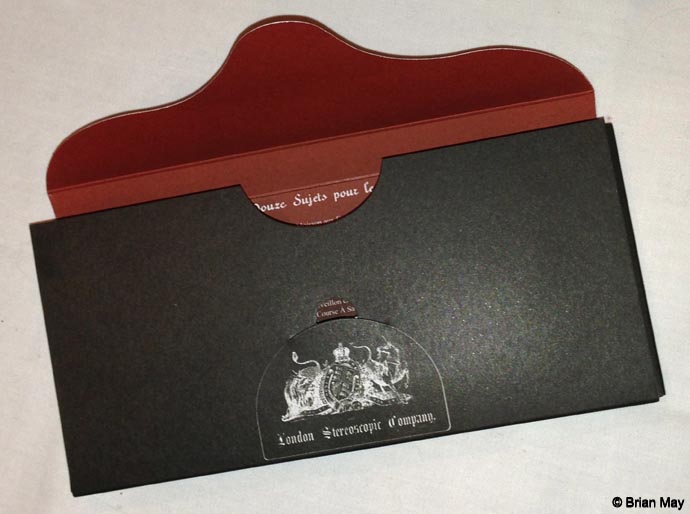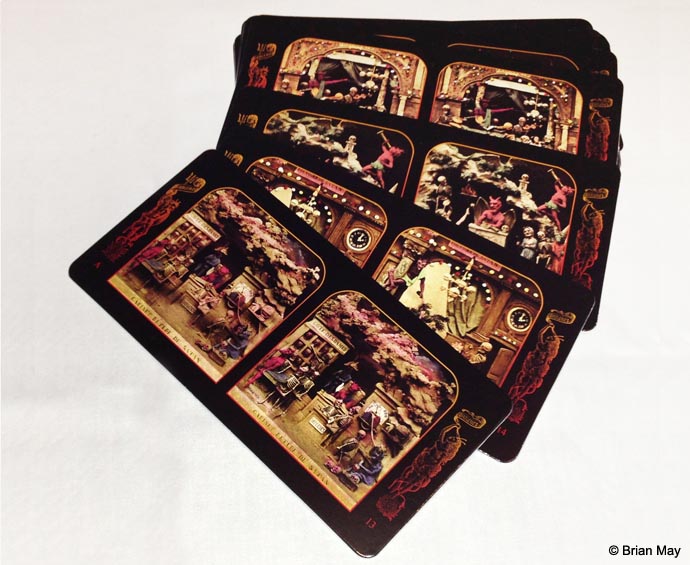Well, the Diableries book is not done yet … though we are on schedule … it’s a Mammoth project, but we are in sight of the finish line … for publication in the summer of this coming year.
But the first box of cards is HERE! And ready to fly out the door …
So what is this all about?
Well, for those who are not yet familiar with the Diableries, let me say a few words. First … look at this.
Here’s a card from the Diableries series.

If you’re lucky enough to come across one of these, in a car boot sale, or antique shop, or auction, this is what it will look like on your desk. Often they are spotty and grubby like this; often they are worse – torn, or scratched and faded, or water-damaged … but occasionally there will be one which miraculously has survived in good shape. It’s a stereo card, of course – French, from the 1860s. The two apparently similar pictures that we see side by side are a stereo pair of images – left and right, corresponding to the exact views our left and right eye would have seen, if we had been there at the photo shoot of this scene. The card is designed to fit into a stereoscope, which ingeniously presents the left image to our left eye, and the right to our right eye, so the miracle of ‘stereopsis’ is recreated – we see a solid, stereoscopic image, and it is as if we are actually there looking at the original scene. The feeling of ‘reality’ is quite shockingly vivid; stereoscopes swept the populations of Britain and France off their feet in the 1850s, and when the effect was rediscovered in the 1950s it became known as ‘3-D’ – three-dimensional imaging … which has now become so popular in 21st century cinema, led by such films as Avatar.
Yes, this is a stereo card – but it’s a special kind. It’s a ‘French Tissue’. The yellow surround to the image is a double layer of cardboard with a yellow coloured glaze on its front surface; between the two layers of this cardboard ‘window’ is a photographic print carrying the stereo pair of images. Why is the photographic print held in this ‘window’ formed by the cardboard frame? Because the makers of these tissues had a nice trick up their sleeves. The image can be illuminated from the front, or from behind. This picture is monochromatic … there was no colour photography in 1860. The image is printed on thin paper coated with albumen (egg white) in which are permanently suspended silver salts, which hold the dark and light areas of the image. To create colour, the makers turned the print over and painted in watercolours on the back. If the card is held up to the light, so it is illuminated mainly from the back, the colours they applied can be seen in transmission, coming through from the back and transforming the whole scene effectively into a colour photograph. The card now looks like this …

There is more magic. As well as adding colours, what the creators of this tissue have done is scratch and pierce the surface of the images, and apply gels on the back, to colour the piercings. The technique is most effectively applied to the eyes of the skeleton characters – producing an eerie glowing effect. In this case, the scratchings also give the illusion of fire around the cauldron. As you can see, the effect, even on this quite faded and damaged example, is pretty striking.
But what are these scenes? How were they made? Well, they are tableaux, table top models containing figures made of clay, and props, and suitable scenery, and each of these ‘dioramas’ tells a story. They depict another world – a world populated by living skeletons, ghouls, ghosts, and devils, all engaged in various ‘diabolical’ activities. They are great fun to view just as ‘Scenes in Hell’, but these images are dripping with dark humour, innuendo and satire … so if one has the key to understanding what was behind their creation, they gain yet another dimension. That is where Denis Pellerin comes in. Having studied these images for more than half a lifetime, and being an expert on an almost forgotten (even to French history students) era of French history, Pellerin has been able to reach into the darkest corners of these amazing images and reveal what they mean. This is the basis of the text of our book, “DIABLERIES: Stereoscopic Adventures in Hell”, which will be on sale next year, all being well.
Not many people in 2012 have ever seen these cards. They are hard to find, and nowadays can be expensive to acquire. And really no living person has ever seen all of these amazing views in good shape. Until now. For the last 5 years or so, I’ve been working with Denis Pellerin, a French photo historian, and Paula Fleming, an American former museum archivist of images, to collect, reproduce, research and annotate ALL the Diableries produced in France between about 1860 and 1900. It’s the first time such a project has been attempted. And we are now close to completing the task.
But what IS already prepared is the first group of our republished Diablerie cards. This is the fulfillment of a dream for me. The reproductions of the cards in our book are restored to the point where 170 years of wear and tear is stripped away, and hopefully we see the cards exactly as they were meant to be seen. But we have long shared the hope that we might be able to produce new card versions of the diableries images, in a form in which they could be enjoyed in the OWL stereoscope, just as the originals could. We have not yet been able to produce tissues as such. But we have taken the restoration process many steps further, to produce images which combine the clarity of the views when front lit with the exotic colours of the backlit versions, and we have carefully realigned and repositioned the pairs of images to make them comfortable to view in the stereoscope. The final magic? Well, it’s different from the 1860s versions, but what we have done is overlay the eyes in shiny foil, so they pick up whatever stray light is around, and make variable sparkling eye effects – a new kind of magic. It’s taken a long time to get to the point where we were satisfied with the quality, but now we have our first sets of 12 cards, ready for your enjoyment.
We’ve put them in new surrounds and numbered them according to their place in the series of 72 originally published by Adolphe Block in 1868. Our first selection is the set of numbers 13 to 24, for reasons we’ll explain later. And there are two bonus cards, one of which is a very modern ‘spoof’ take on the genre, called “Queen en Enfer” (Queen in Hell) modelled by Ed Donnen, and the other is the mysterious and unique A(0) – Enfer – which we have already seen as an original card, above. This is what our cards look like.

We can’t show you exactly what the eyes do on a computer. These are physical things – not digital!
But this close-up might give an idea of how they sparkle …

Very rarely the original cards are found in boxes, and it is on these boxes we have modelled ours for these new sets.


Here are the first 12 ‘out of the box’ …

So, folks, this is what we will have on sale in a day or so. We hope you’ll enjoy.
I’ll publish details of how to purchase your sets in the next message. There will also be details of the new OWL’s NESTS!!! Yes, it’s all too much to take in, isn’t it !
Cheers!
Brian
© brianmay.com